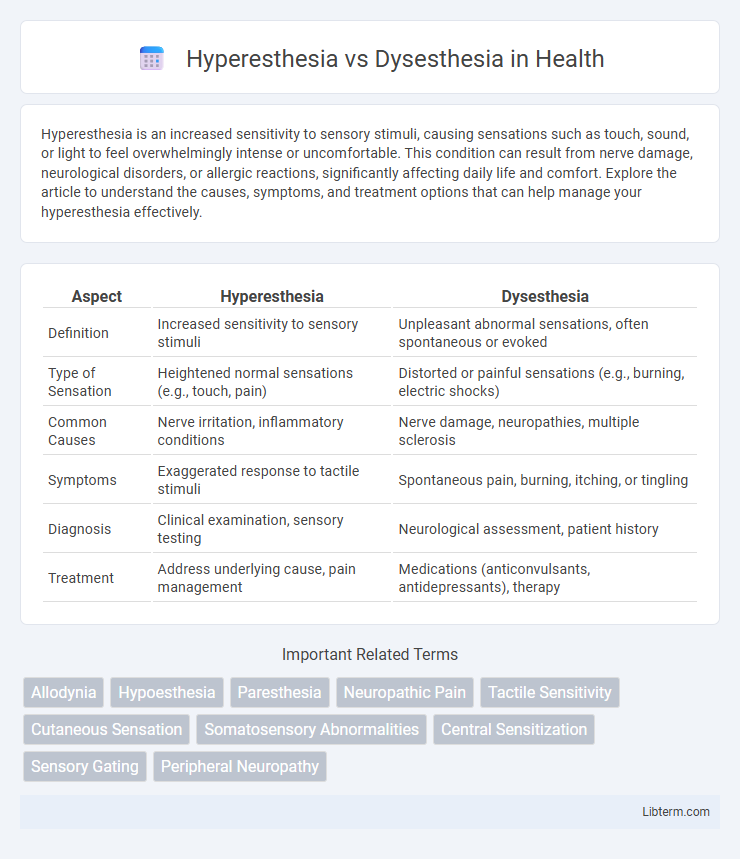Hyperesthesia is an increased sensitivity to sensory stimuli, causing sensations such as touch, sound, or light to feel overwhelmingly intense or uncomfortable. This condition can result from nerve damage, neurological disorders, or allergic reactions, significantly affecting daily life and comfort. Explore the article to understand the causes, symptoms, and treatment options that can help manage your hyperesthesia effectively.
Table of Comparison
| Aspect | Hyperesthesia | Dysesthesia |
|---|---|---|
| Definition | Increased sensitivity to sensory stimuli | Unpleasant abnormal sensations, often spontaneous or evoked |
| Type of Sensation | Heightened normal sensations (e.g., touch, pain) | Distorted or painful sensations (e.g., burning, electric shocks) |
| Common Causes | Nerve irritation, inflammatory conditions | Nerve damage, neuropathies, multiple sclerosis |
| Symptoms | Exaggerated response to tactile stimuli | Spontaneous pain, burning, itching, or tingling |
| Diagnosis | Clinical examination, sensory testing | Neurological assessment, patient history |
| Treatment | Address underlying cause, pain management | Medications (anticonvulsants, antidepressants), therapy |
Introduction to Hyperesthesia and Dysesthesia
Hyperesthesia refers to an increased sensitivity to sensory stimuli, often causing heightened perception of touch, sound, or pain. Dysesthesia is characterized by abnormal, unpleasant sensations that occur spontaneously or in response to stimuli, such as burning, itching, or electric shock-like feelings. Both conditions are linked to nerve dysfunction and can result from various neurological disorders or injuries.
Definitions: Hyperesthesia vs Dysesthesia
Hyperesthesia refers to an increased sensitivity to sensory stimuli, causing normal sensations to feel intensified or exaggerated. Dysesthesia is characterized by unpleasant, abnormal sensations, often described as burning, tingling, or electric shocks, occurring without an apparent external stimulus. Both conditions involve sensory perception abnormalities but differ in the nature and quality of the sensations experienced.
Causes and Risk Factors
Hyperesthesia is caused by nerve damage, infections, or neurological disorders such as multiple sclerosis, leading to an increased sensitivity to sensory stimuli. Dysesthesia often results from peripheral neuropathy, spinal cord injuries, or diabetes, causing unpleasant abnormal sensations like burning or electric shocks. Risk factors for both conditions include trauma, chronic diseases, autoimmune disorders, and exposure to toxins that affect nerve function.
Key Symptoms and Clinical Presentation
Hyperesthesia presents with an increased sensitivity to stimuli, causing exaggerated responses to touch, sound, or light, often experienced as discomfort or pain. Dysesthesia involves abnormal sensations such as burning, tingling, or electric shocks, typically spontaneous or provoked by non-noxious stimuli. Clinically, hyperesthesia is marked by heightened stimulus perception, while dysesthesia is characterized by unpleasant, often painful abnormal sensations without external stimuli.
Underlying Neurological Mechanisms
Hyperesthesia involves an increased sensitivity of sensory receptors, often linked to heightened activity in the peripheral nervous system or specific central nervous system pathways such as the somatosensory cortex. Dysesthesia results from abnormal neurological processing, typically involving maladaptive plasticity or nerve damage leading to aberrant signaling in the central or peripheral nervous systems. Both conditions reflect disruptions in neural transmission, with hyperesthesia indicating amplified normal signals and dysesthesia involving distorted or unpleasant sensations caused by altered neural pathways.
Diagnostic Criteria and Assessment Tools
Hyperesthesia presents as an increased sensitivity to sensory stimuli, often diagnosed through quantitative sensory testing (QST) that measures thresholds for touch, vibration, and temperature. Dysesthesia involves unpleasant, abnormal sensations typically assessed using patient-reported outcome measures and clinical examination identifying spontaneous or evoked discomfort. Both conditions require neurological evaluation, with nerve conduction studies and somatosensory evoked potentials providing objective data to differentiate sensory dysfunction patterns.
Common Conditions Associated with Each
Hyperesthesia commonly occurs in conditions like neuropathies, fibromyalgia, and migraines where the nervous system becomes overly sensitive to stimuli. Dysesthesia is frequently associated with multiple sclerosis, peripheral nerve injury, and diabetic neuropathy, characterized by unpleasant, abnormal sensations often without external stimuli. Both conditions reflect underlying nerve dysfunction but differ in symptom quality and associated disorders.
Treatment Approaches for Hyperesthesia
Treatment approaches for hyperesthesia primarily involve addressing the underlying cause, such as neuropathic pain or nerve injury. Therapies include the use of anticonvulsants like gabapentin, topicals such as lidocaine patches, and physical therapy to help desensitize affected areas. In some cases, cognitive-behavioral therapy (CBT) and pain management strategies may be recommended to improve patient outcomes.
Management Strategies for Dysesthesia
Management strategies for dysesthesia primarily involve pharmacological treatments such as anticonvulsants, antidepressants, and topical lidocaine to alleviate abnormal sensations. Non-pharmacological approaches include physical therapy, cognitive-behavioral therapy, and nerve stimulation techniques to improve nerve function and reduce discomfort. Early intervention and tailored treatment plans based on symptom severity enhance overall patient outcomes in dysesthesia management.
Prognosis and Patient Quality of Life
Hyperesthesia often results in heightened sensitivity to stimuli, but with appropriate therapy, many patients experience symptom reduction and maintain a favorable quality of life. Dysesthesia, characterized by unpleasant abnormal sensations, tends to have a more variable prognosis depending on underlying causes, and chronic cases can significantly impair daily functioning and psychological well-being. Effective management strategies, including medications and rehabilitation, play a critical role in improving long-term outcomes and enhancing patient quality of life for both conditions.
Hyperesthesia Infographic

 libterm.com
libterm.com